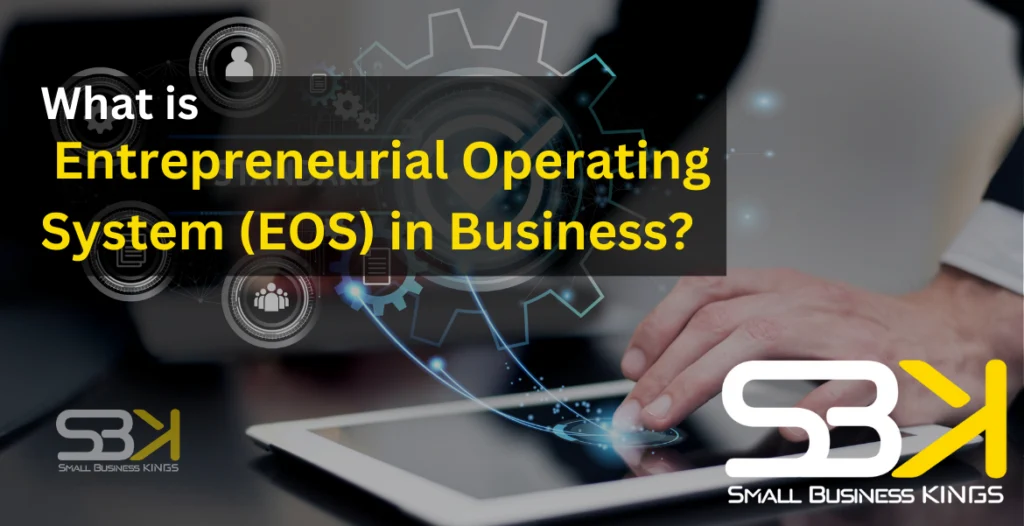In today’s fast-paced business world, keeping everything running smoothly can be a daunting task.
You might have heard about various systems designed to streamline operations, but one that’s gaining a lot of traction lately is the Entrepreneurial Operating System, or EOS. But what exactly is EOS, and how can it transform your business? Let’s dive in!
What is EOS?
The Entrepreneurial Operating System (EOS) is a comprehensive business management system created by Gino Wickman. It was designed to help entrepreneurs and their leadership teams get what they want from their businesses. By focusing on six key components of any organization, EOS provides a set of simple, practical, and real-world tools to help you strengthen and grow your business.
The EOS Model
EOS is built around six key components that every business must master to achieve success:
Vision
The Vision component is all about getting everyone in the organization on the same page. It involves clearly defining and communicating where the organization is going and how it plans to get there.
People
This component emphasizes having the right people in the right seats. It focuses on building a strong team where each member is not only skilled but also a perfect fit for their role.
Data
Data is critical for making informed decisions. The Data component involves identifying and tracking key metrics that give you an accurate picture of your business’s performance.
Issues
Every business faces issues, but how you handle them makes all the difference. This component focuses on identifying and addressing problems effectively through a structured process.
Process
Consistency is key to efficiency. The Process component involves documenting and standardizing core processes to ensure everyone follows them, leading to more predictable outcomes.
Traction
Finally, Traction is about bringing the vision down to the ground and making it happen. This involves setting clear priorities and maintaining a rhythm of accountability.
The Vision Component
Getting your vision right is the first step. You need to clarify your long-term and short-term goals and ensure everyone in the organization understands them. This unified vision keeps everyone aligned and moving in the same direction.
The People Component
Having the right people in the right roles is crucial for success. EOS uses an Accountability Chart to clarify roles and responsibilities. This ensures that everyone knows what they are accountable for, which increases efficiency and reduces confusion.
The Data Component
To make smart decisions, you need reliable data. EOS emphasizes creating a Scorecard that tracks key metrics weekly. This helps you stay on top of your business and make adjustments as needed.
The Issues Component
Problems are inevitable, but EOS provides a framework to tackle them head-on. The IDS (Identify, Discuss, Solve) process ensures that issues are dealt with promptly and effectively, preventing them from snowballing into bigger problems.
The Process Component
Documenting your processes might seem tedious, but it pays off in the long run. By having clear, documented processes, you ensure that everyone knows the best way to do their job. This leads to consistency and efficiency across the board.
The Traction Component
Traction is where the rubber meets the road. It involves setting 90-day priorities (Rocks) and establishing a regular meeting rhythm to review progress. This keeps everyone focused and accountable.
Implementing EOS
Implementing the Entrepreneurial Operating System (EOS) in your business involves a structured approach to ensure a smooth transition and effective adoption.
- Read the Foundational Books
- Start by reading “Traction” by Gino Wickman to grasp the fundamentals of EOS. Follow up with other EOS literature such as “Get a Grip” and “Rocket Fuel” to deepen your understanding.
- Assess Your Current State
- Conduct a thorough assessment of your business to identify current strengths, weaknesses, and areas for improvement. This helps in understanding where EOS can make the most impact.
- Build Your Leadership Team
- Assemble a dedicated leadership team committed to implementing EOS. This team should include key decision-makers who can drive change across the organization.
- Create Your Vision/Traction Organizer (V/TO)
- Use the V/TO tool to clearly define your company’s core values, core focus, 10-year target, marketing strategy, 3-year picture, 1-year plan, and quarterly Rocks (priorities).
- Hire an EOS Implementer (Optional but Recommended)
- Consider hiring a professional EOS Implementer. These experts can provide guidance, facilitate meetings, and ensure that your team adheres to the EOS process correctly.
- Set Up Your Accountability Chart
- Develop an Accountability Chart to clarify roles and responsibilities within your organization. Unlike traditional organizational charts, this focuses on function over hierarchy.
- Establish a Meeting Rhythm
- Implement regular meeting cadences such as weekly Level 10 Meetings. These structured meetings help in tracking progress, solving issues, and maintaining alignment.
- Document Your Core Processes
- Identify your business’s core processes, document them, and ensure they are followed by all team members. This step is crucial for maintaining consistency and efficiency.
- Track Your Data
- Develop a Scorecard to track key metrics and measurables that indicate the health of your business. Review these metrics weekly to make informed decisions.
- Identify and Solve Issues (IDS)
- Use the IDS process (Identify, Discuss, Solve) during your meetings to tackle and resolve issues promptly. This ensures problems are addressed systematically and do not hinder progress.
- Review and Adjust
- Regularly review your progress with the leadership team. Adjust your strategies and processes as needed to stay on track with your goals.
Benefits of EOS
Implementing EOS offers numerous benefits:
- Clarity and Focus: Everyone knows where the business is headed and how to get there.
- Accountability: Clear roles and responsibilities ensure that tasks are completed efficiently.
- Improved Problem-Solving: A structured approach to addressing issues leads to quicker and more effective solutions.
Challenges of EOS
Like any system, EOS comes with its challenges:
- Resistance to Change: People may be resistant to new processes.
- Time Commitment: Implementing EOS requires a significant time investment.
- Consistency: Ensuring everyone follows the documented processes can be difficult.
EOS Tools and Resources
To get started with EOS, you can use various tools and resources:
- Books: “Traction” by Gino Wickman, “Get a Grip” by Gino Wickman and Mike Paton.
- Software: Platforms like Ninety.io offer tools to manage your EOS process.
- Workshops and Webinars: These provide additional training and support.
FAQs
- What size company benefits most from EOS?
EOS is ideal for small to mid-sized companies with 10-250 employees, but its principles can be scaled to fit businesses of any size. - How long does it take to implement EOS?
Implementation typically takes around two years, but you may start seeing benefits within the first few months. - Can EOS be customized for different industries?
Yes, EOS is flexible and can be adapted to fit the specific needs of various industries. - What training is required to implement EOS?
No formal training is required, but reading the EOS books and possibly working with an EOS Implementer can be very beneficial. - How does EOS compare to other business operating systems?
EOS is known for its simplicity and practicality, making it easier to implement and maintain compared to some other more complex systems.




